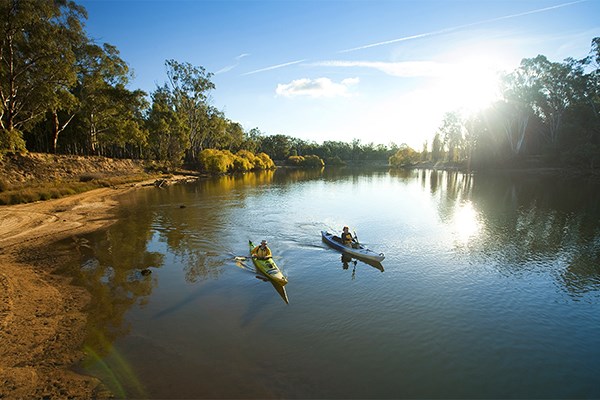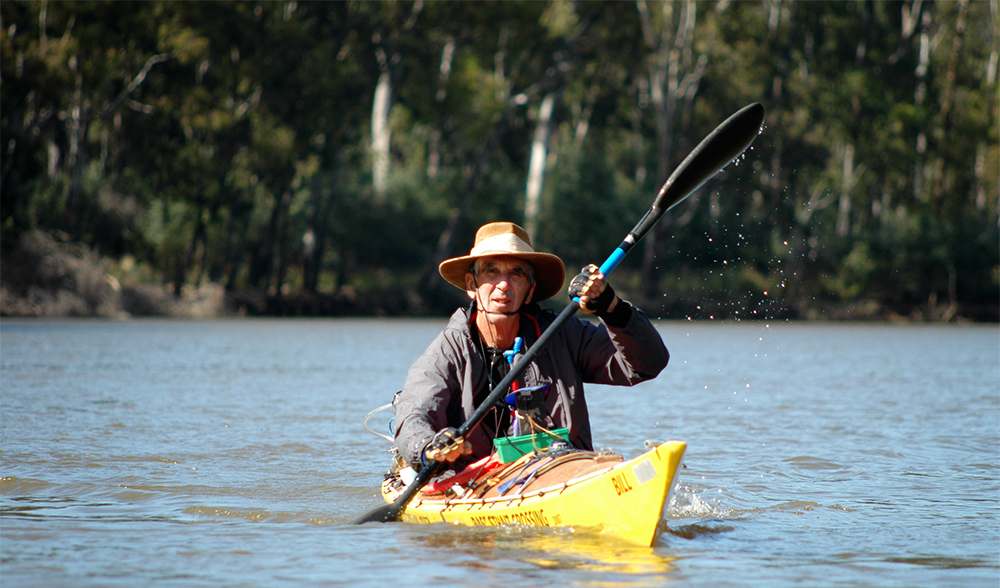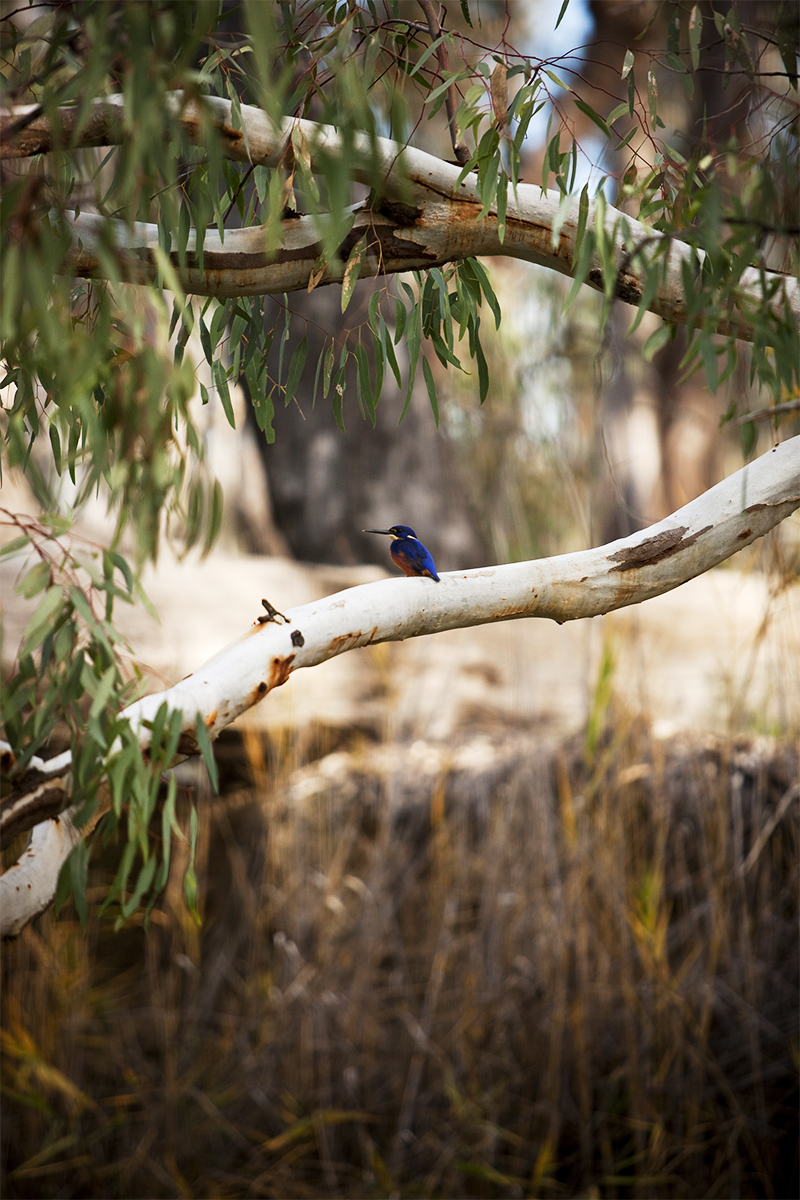The Murray River is too busy celebrating life to acknowledge death. By a bush camp within the Barmah Forest, the Murray rushes around a fallen giant. This colossus may, before it was grey and leafless, have been a partner of the water for 500 years. But the Murray isn’t slowing to mourn the river red gum’s passing – not any more. Not since the floods.
The Murray has been on life-support for more than a decade, but after the heavy rains of 2010 it has – for now, at least – made a remarkable recovery. This river’s up and about. There’s no time for sorrow.
Sea kayaker Bill Robinson knows the Murray well. He and I have come to paddle 130km between Tocumwal and Barmah after the floods. Each night we set up camp barely a guide rope’s length from the water, under river red gums bursting with shoots of green. We moor two sea kayaks, pitch tents, light a small fire.






Inevitably we camp near a gum that’s toppled into the river – the riff as the water rushes around it is unmistakably a rejoicing of sorts; it’s even sweet enough to ease a sore arse. But best not to dwell on that.
For 67-year-old Bill might laugh. In 2005, Bill paddled the length of the Murray, from Yarrawonga to Goolwa at the mouth. He stroked for 1987km, it took him five weeks in a kayak he built himself. The man has completed 22 Murray Marathons, won his class numerous times. His colleagues at the Victorian Sea Kayak Club believe there are few people who’ve paddled as many kilometres on the Murray River as Bill.
On our paddle, the retired veterinary surgeon will barely move out of first gear. I’ll be following his lead all the way, for I might learn a few things. Not only about the Murray but perhaps a few of life’s essential skills: on Port Phillip Bay, near his home, the fella once caught 22kg of salmon in a hour, using 15 metres of venetian blind cord wrapped around a rubber thong. He likes to invent things, does Bill.
The Murray River rambles for 2530km from its source in Kosciuszko National Park to its mouth, according to the Murray-Darling Basin Authority. We are going to paddle along Bill’s favourite part – the river and slabs of forest between Tocumwal and Barmah.
LAUNCH TIME
We begin at the Tocumwal boat ramp, near the distinctive blue 1886 marker (the number of kilometres to the mouth is signposted at regular intervals). “I’ve never seen the river running so fast,” says Bill. It’s running at about three to five km/h. At this rate, without paddling a stroke, and ignoring the urge to eat and sleep, we could be at the mouth in four weeks.
After a two-hour paddle, a sandbank appears. It is just after midday, about 27 degrees, there is no wind, the river runs smooth. The patch of deserted sand would be impossible to paddle past even if we’d just swallowed breakfast.
We unload the victuals, Bill puts a flame to his cherished Trangia (we only light a fire in the evenings). “I’m more at home on the river than in pubs and restaurants,” says Bill, peeling open a tin of sardines.
Bill has studied nutrition and, on expeditions, eats for fuel as much as taste. Sardines are one of his staples: he’d rather eat them from a tin on the banks of the Murray than in a five-star restaurant. “We are eating in the best restaurant in Australia,” he says.
Back in the kayaks, alternating between drifting and paddling, Bill talks more of his affection for this stretch of the river. “The Murray is a hard-working river,” he says. “The further down you go, the harder it works agriculturally. It gets very little human intervention here. It’s very much the Murray as it has been, [but] I haven’t seen the river this good for 20 years.”
CAMP SOLITUDE
The first day we paddle 42km. At dusk, as smoke drifts from our campfire, the river red gum forest is alight with a fiery glow. Not even a tinnie slinks by.
During the drought, Bill had to haul his kayak up out of the water but we have paddled almost right up to a patch of grass. Bill camped along the Murray during the peak of the drought (from 1997-2010) and says he could almost walk across the river then.
We use our small fire to cook our rice, brew tea and prepare water for a five-minute hot shower. Bill’s rigged up his own ablution system and showering each evening is a Murray ritual. In this camp there is little chance of being happened upon. “The [four-wheel-drive] tracks have been wet all year,” he explains.
From Tocumwal to Picnic Point, there is limited vehicle access to the riverbanks. In 2011, catchments continued to release water into the Murray and the flow-on effect is that many forest tracks and campsites are inaccessible to vehicles.
While this may be wonderful news for bashful kayakers, many fishers and campers can’t access their favourite parts of the river and, in a blow for tourism, are staying away from some river towns.
The farmers, of course, have seen their own tragically tough times and the mud-stained trunks of the trees, a metre or so above current water levels, only hint at the flood devastation.
SPIRITUAL CONNECTION
On our first night around the fire Bill speaks reverently of the five weeks he spent living alone on the Murray. For this atheist, it was as close as he’ll come to a religious experience. Bill believes that time gave him the barest inkling of the connection between the Yorta Yorta people and the river and forests.
Some of Bill’s knowledge of indigenous people comes from Ted Jackson, one of his great paddling mates. “Ted, whose grandmother was Aboriginal, paddled solo from Killarney in Queensland to the mouth of the Murray. He slept under his boat in the evenings,” recounts Bill.
Ted served in World War II and “wasn’t much bigger than a Bren gun”. He was a bushman and whether on the river or working in the outback he knew how to keep himself entertained. “He could recite anything from C.J. Dennis,” says Bill. In 2003, when Ted was 82, the duo completed the Murray Marathon and the Murray 200 together.
Both men developed their own connection with the river and applauded when, in 2004, the Victorian Government signed a historic agreement with the Yorta Yorta Nation, formally acknowledging this indigenous people’s rights to manage their ancestral lands. The agreement was the first of its kind in Australia and the Yorta Yorta became co-managers of 50,000 hectares of Crown land.
Aborigines used canoes for fishing, setting nets and river crossings; typically their canoes were made from single sheets of red gum bark. My six-metre Eco-bezhig sea kayak can carry two week’s worth of rations and, fortunately, given my predilection for paddling over fallen trees lurking just underwater, is designed to take a pounding.
Each day we paddle for about six hours, three sessions of two hours. The paddling’s not effortless but nor is it taxing, not even when the heat bites. Each night, we light a small fire, fuelled by gum leaves and twigs. Always we are drawn to it, captivated by it. “It’s basic humanity,” says Bill.
NO CURE-ALL
Before Picnic Point on day three, the Edward-Wakool, an anabranch of the Murray, slinks off into Millewa Forest toward Deniliquin. (The Barmah Forest lies on the Victorian side of the Murray, the Millewa on the NSW side and the twinned Barmah-Millewa is Australia’s largest river red gum forest).
The Wakool was once the main path of the river. But the drought reduced inflows into the Wakool system so severely that by 2007 it had dried to a chain of pools. Now the water fairly scuds into it. Yet this liquid elixir isn’t necessarily a complete cure for any of the Murray’s wetland systems.
Australian Wetlands and Rivers Centre director Professor Richard Kingsford says wetlands along the Murray were parched for so long that it is difficult to predict just how much water they will soak up. And there are flood plains from Albury to the Coorong, meaning the water system is defined by much more than the main river channel.
A lot of trees on the edges of the Barmah and Millewa forests have been dying because there is not enough water, Richard says. “On most of the flood plains within the Murray-Darling the large vegetation communities are contracting inwards. They are dying on the edges.”
BLISS FOR BIRDERS
At Picnic Point we stop for a break. An azure kingfisher flits between our kayaks. Seeing the bird sitting there, preening atop the kayak’s rudder, is every bit as perfect a moment as sleeping under the stars.
There are a lot more people and tinnies hereabouts. As we paddle a woman beckons to us from the caravan park: “Would you like a cup of coffee?”
The 8km-long Barmah Choke, beyond Picnic Point, is the narrowest (about 30m wide) part of the river between Albury and the Coorong. On both sides of the Murray, the river red gums and their new shoots create a boulevard of green. The river’s pulse quickens.
As we close in on the lakes a sea eagle cruises above the red gums. Others are on the hunt too. For the first time we follow in the wake of fishers and their boats. The territorial Murray cod is reportedly showing its best numbers in decades.
For gums that topple into the water, death isn’t finite – the fallen have an afterlife. The cod move in and use tree hollows as nurseries, as places to lay their eggs.
There are 240 bird species found around Barmah Lakes, including black swans, whistling kites and superb parrots. Yet not all that flits about these rich waters is obvious at first.
ENTER BAT WOMAN
Rachel Blakey is an ecologist from the University of New South Wales. The PhD candidate stayed in a cabin next to mine at Barmah Caravan Park. She and her crew were trapping bats in the Barmah Forest and had been in town a few days. Locals had affectionately given Rachel a nickname.
“Bat Woman” was on the hunt for populations of the elusive fishing bat (Myotis macropus), the only Australian bat to forage almost entirely over water as it trawls the river’s surface for small fish and insects with its oversized feet.
Bill has his own insights into the winged world; a blue wren flitting through camp on our last night provides inspiration for another yarn. “The blue wren is a flying testicle,” he says. “He is pure testosterone; his testicle as a proportion of body weight is the greatest of all birds and animals.” The wren is not, however, his favourite bird. Boobook owls are oftentimes river companions. “There is hardly a night on the Murray without the [hooting of] boobook,” says Bill.
THE FINAL STRETCH
Emerging from the Choke near Snake Island, we spy the river red gum into which Augustus Peirce reportedly etched the number 264. Born in America, the river boat captain prepared a navigation chart of the Murray in 1864 and carved his survey numbers into gums by the river’s edge. From here, it is some 10km until Barmah.
It’s time to paddle solo; Bill gives me a lengthy start. There is no plan to get lost, but should it happen there are rations in the day hatch, water in Bill’s bespoke system that sits around my neck and a plastic bottle the inventor’s remodelled for me to piss in (unused before this trip, he pledged).
As my paddle slices through the water, it plays its own musical notes. They are as mesmerising as the Murray’s voice and each sound takes me to places further, much further west. I’m living with the river, feeling part of it and am lost, after all – to a Goolwa-bound delusion that makes this real trip’s end a little easier to confront.
Bill is again set to kayak the length the Murray. He’s planning to share the river, its music, the birds, his campfire and the mighty river red gums with a friend from the US. She’s an ex-soldier, a veteran of two tours to Iraq. Perhaps she too is celebrating life.





